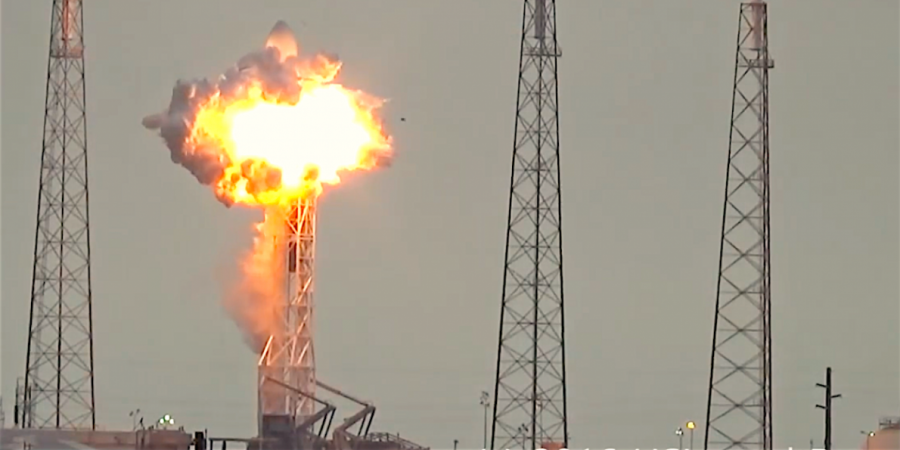SpaceX Blast
On the morning of September 1, just before a routine pre-flight ignition test, a SpaceX Falcon 9 rocket exploded. In an instant, the 277 foot-tall space vehicle and its $200 million satellite cargo disappeared into a ball of flames.
SpaceX has been fairly quiet with details on what went wrong last month on Launch Complex 40 at Cape Canaveral. This makes sense, but considering it is SpaceX’s second launch failure in 15 months, the explosion is a more tangible measure of the company’s future than its highly-publicized (and hypothetical) plan to settle Mars. Last Friday, the Wall Street Journal reported that the problem may have been operational, rather than a manufacturing or design flaw of the rocket itself. But that does not mean the case is that simple. Nothing involving rockets ever is.
The investigation itself is a collaborative effort between SpaceX, the FAA, NASA, the US Air Force, and industry experts. Together, they are looking at over 3,000 channels of engineering data, along with video, audio and imagery, the company said. Early rumors speculated that SpaceX was worried about potential sabotage by rival space firms, and were reviewing images of a strange shadow on a building next to the launch site. But mostly, the investigation has focused on the second stage liquid oxygen tank, or, more specifically, on the cryogenic helium system inside the liquid oxygen tank. Basically, this is the fuel that would have helped the Falcon 9’s cargo, an Amos-6 communications satellite, maneuver from Low Earth Orbit into Geostationary Transfer Orbit. But even that level of detail masks a confounding number of possibilities.
To start, a design flaw or some part of the pre-flight process caused the explosion. “It could be good if it turns out to be an operational problem, because that is easily remedied, rather than a design or manufacturing problem,” said Scott Pace, director of the Space Policy Institute at George Washington University. “But you have to ask why did that operation failure happen. Was their lack of training or understanding of what was going on?” Pace said he’d like to know whether investigators from SpaceX and the Federal Aviation Administration, which oversees the accident, have proof that the fueling failure was what occurred, or did they eliminate other faults and the fueling operation what was remained? “Was it that people felt rushed?” Pace said. “Was there schedule pressure, were they doing something innovative. Was it something else?”
NASA officials in Washington referred questions to the FAA’s Office of Commercial Spaceflight. And the FAA spokesman for that office did not answer questions. This means experts and amateurs in the space-interested public can only speculate.
The investigation itself might inevitably hit a wall of conjecture. “They are looking at some of the charred remains to see what part failed and was there a manufacturing problem,” says Marco Caceres, a space industry analyst at the Vienna, VA, based Teal Group. “Or was it just a one of those freak accidents? I’m not sure they are every going to know exactly.”
The timeline of the explosion was extremely short – from first signs of an anomaly to loss of data was about 93 milliseconds or less than 1/10th of a second. And though the investigators have access to thousands of data streams from that short period, they would have had much more if the explosion had occurred when the rocket were launching, or in flight. Then, thousands of cameras would have been streaming info from all angles of the rocket, and additional sensors would be feeding into flight control computers.
For his contribution to the speculation, Caceres noted that a fueling failure could occur from a small piece of brittle metal that begins vibrating, breaks apart, lodges into a fuel line and causes combustion. SpaceX is testing this sort of malfunction at its McGregor, TX, facility.
Finding out what happened to this rocket is important. The Falcon 9 is SpaceX’s workhorse, scheduled to carry the brunt of the 70 commercial satellite launches, a $10 billion backlog, waiting to go into orbit. Oh and also, the rocket is part of SpaceX’s bid for a $2.6 billion NASA contract to send astronauts to the International Space Station. Those ISS crew flights have already been delayed until 2018 at the earliest, three years past NASA’s original launch date, according to a NASA Inspector General’s report released the day of the explosion.
SpaceX has lost only 2 of its 29 launches. Until the investigation bears out, nobody will know if those failures follow any kind of pattern. In the meantime, Musk’s company continues to sign up new customers. Should those customers be worried? Well, there’s no simple answer.

Nicholas Headley is a senior and a Journalism student.
Nicholas is involved in marching and concert band, Drama Club, Student Council, and is a member...



